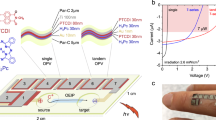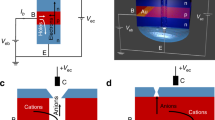Abstract
Cells and tissues use finely regulated ion fluxes for their intra- and intercellular communication. Technologies providing spatial and temporal control for studies of such fluxes are however, limited. We have developed an electrophoretic ion pump made of poly(3,4-ethylenedioxythiophene) doped with poly(styrene sulphonate) (PEDOT:PSS) to mediate electronic control of the ion homeostasis in neurons. Ion delivery from a source reservoir to a receiving electrolyte via a PEDOT:PSS thin-film channel was achieved by electronic addressing. Ions are delivered in high quantities at an associated on/off ratio exceeding 300. This induces physiological signalling events that can be recorded at the single-cell level. Furthermore, miniaturization of the device to a 50-μm-wide channel allows for stimulation of individual cells. As this technology platform allows for electronic control of ion signalling in individual cells with proper spatial and temporal resolution, it will be useful in further studies of communication in biological systems.
This is a preview of subscription content, access via your institution
Access options
Subscribe to this journal
Receive 12 print issues and online access
$259.00 per year
only $21.58 per issue
Buy this article
- Purchase on Springer Link
- Instant access to full article PDF
Prices may be subject to local taxes which are calculated during checkout





Similar content being viewed by others
References
Andersson, P. et al. Active matrix displays based on all-organic electrochemical smart pixels printed on paper. Adv. Mater. 14, 1460–1464 (2002).
Pei, Q. B., Zuccarello, G., Ahlskog, M. & Inganäs, O. Electrochromic and highly stable poly(3,4-ethylenedioxythiophene) switches between opaque blue-black and transparent sky blue. Polymer 35, 1347–1351 (1994).
Nilsson, D., Kugler, T., Svensson, P.-O. & Berggren, M. An all-organic sensor-transistor based on a novel electrochemical transducer concept printed electrochemical sensors on paper. Sensors Actuators B 86, 193–197 (2002).
Zhu, Z. T. et al. A simple poly(3,4-ethylene dioxythiophene)/poly(styrene sulfonic acid) transistor for glucose sensing at neutral pH. Chem. Commun. 13, 1556–1557 (2004).
Mabeck, J. & Malliaras, G. Chemical and biological sensors based on organic thin-film transistors. Anal. Bioanal. Chem. 384, 343–353 (2006).
Jager, E. W. H., Smela, E. & Inganas, O. Microfabricating conjugated polymer actuators. Science 290, 1540–1545 (2000).
Smela, E., Inganas, O. & Lundstrom, I. Controlled folding of micrometer-size structures. Science 268, 1735–1738 (1995).
Isaksson, J., Tengstedt, C., Fahlman, M., Robinson, N. & Berggren, M. A solid-state organic electronic wettability switch. Adv. Mater. 16, 316–320 (2004).
Abidian, M. R., Kim, D. H. & Martin, D. C. Conducting-polymer nanotubes for controlled drug release. Adv. Mater. 18, 405–409 (2006).
George, P. M. et al. Electrically controlled drug delivery from biotin-doped conductive polypyrrole. Adv. Mater. 18, 577–581 (2006).
Karlsson, R., Karlsson, A. & Orwar, O. A nanofluidic switching device. J. Am. Chem. Soc. 125, 8442–8443 (2003).
Xu, H., Wang, C., Wang, C. L., Zoval, J. & Madou, M. Polymer actuator valves toward controlled drug delivery application. Biosensors Bioelectron. 21, 2094–2099 (2006).
Kontturi, K., Murtomaki, L., Pentti, P. & Sundholm, G. Preparation and properties of a pyrrole-based ion-gate membrane as studied by the EQCM. Synth. Met. 92, 179–185 (1998).
Miller, L. L. Electrochemically controlled release of drugs and other chemicals. Reactive Polymers, Ion Exchangers, Sorbents 6, 341 (1986).
Lira, L. M. & de Torresi, S. I. C. Conducting polymer-hydrogel composites for electrochemical release devices: Synthesis and characterization of semi-interpenetrating polyaniline-polyacrylamide networks. Electrochem. Commun. 7, 717–723 (2005).
Yates, B. J. et al. Electrochemical control of solid phase micro-extraction: Conducting polymer coated film material applicable for preconcentration/analysis of neutral species. Talanta 58, 739–745 (2002).
Wong, J. Y., Langer, R. & Ingber, D. E. Electrically conducting polymers can noninvasively control the shape and growth of mammalian-cells. Proc. Natl Acad. Sci. USA 91, 3201–3204 (1994).
Nyberg, T., Inganäs, O. & Jerregård, H. Polymer hydrogel microelectrodes for neural communication. Biomed. Microdev. 4, 43–52 (2002).
Chung, B. G., Lin, F. & Jeon, N. L. A microfluidic multi-injector for gradient generation. Lab Chip 6, 764–768 (2006).
Irimia, D. et al. Microfluidic system for measuring neutrophil migratory responses to fast switches of chemical gradients. Lab Chip 6, 191–198 (2006).
Berridge, M. J. Calcium oscillations. J. Biol. Chem. 265, 9583–9586 (1990).
Berridge, M. J., Bootman, M. D. & Lipp, P. Molecular biology: Calcium—a life and death signal. Nature 395, 645–648 (1998).
Berridge, M. J., Bootman, M. D. & Roderick, H. L. Calcium signalling: Dynamics, homeostasis and remodelling. Nature Rev. Mol. Cell Biol. 4, 517–529 (2003).
George, P. M. et al. Fabrication and biocompatibility of polypyrrole implants suitable for neural prosthetics. Biomaterials 26, 3511–3519 (2005).
Wang, X. et al. Evaluation of biocompatibility of polypyrrole in vitro and in vivo. J. Biomed. Mater. Res. A 68, 411–422 (2004).
Cui, X. & Martin, D. C. Electrochemical deposition and characterization of poly(3,4-ethylenedioxythiophene) on neural microelectrode arrays. Sensors Actuators B 89, 92–102 (2003).
Peyrl, A., Krapfenbauer, K., Slavc, I., Strobel, T. & Lubec, G. Proteomic characterization of the human cortical neuronal cell line HCN-2. J. Chem. Neuroanat. 26, 171–178 (2003).
Ronnett, G. V., Hester, L. D., Nye, J. S. & Snyder, S. H. Human cerebral cortical cell lines from patients with unilateral megalencephaly and Rasmussen’s encephalitis. Neuroscience 63, 1081–1099 (1994).
Bobacka, J., Lewenstam, A. & Ivaska, A. Electrochemical impedance spectroscopy of oxidized poly(3,4-ethylenedioxythiophene) film electrodes in aqueous solutions. J. Electroanal. Chem. 489, 17–27 (2000).
Vázquez, M., Danielsson, P., Bobacka, J., Lewenstam, A. & Ivaska, A. Solution-cast films of poly(3,4-ethylenedioxythiophene) as ion-to-electron transducers in all-solid-state ion-selective electrodes. Sensors Actuators B 97, 182–189 (2004).
Lisowska-Oleksiak, A., Kazubowska, K. & Kupniewska, A. Ionic transport of Li+ in polymer films consisting of poly(3,4-ethylenedioxythiophene) and poly(4-styrenesulphonate). J. Electroanal. Chem. 501, 54–61 (2001).
Lisowska-Oleksiak, A. & Kupniewska, A. Transport of alkali metal cations in poly(3,4-ethylenethiophene) films. Solid State Ion. 157, 241–248 (2003).
Wang, X., Shapiro, B. & Smela, E. Visualizing ion currents in conjugated polymers. Adv. Mater. 16, 1605–1609 (2004).
Krische, B. & Zagorska, M. Overoxidation in conducting polymers. Synth. Met. 28, C257–C262 (1989).
Tehrani, P. et al. Patterning polythiophene films using electrochemical over-oxidation. Smart Mater. Struct. 14, 21–25 (2005).
Zotti, G. et al. Electrochemical and XPS studies toward the role of monomeric and polymeric sulfonate counterions in the synthesis, composition, and properties of poly(3,4-ethylenedioxythiophene). Macromolecules 36, 3337–3344 (2003).
Ghosh, S., Rasmusson, J. & Inganas, O. Supramolecular self-assembly for enhanced conductivity in conjugated polymer blends: Ionic crosslinking in blends of poly(3,4-ethylenedioxythiophene)-poly(styrenesulfonate) and poly(vinylpyrrolidone). Adv. Mater. 10, 1097–1099 (1998).
Groenendaal, B. L., Jonas, F., Freitag, D., Pielartzik, H. & Reynolds, J. R. Poly(3,4-ethylenedioxythiophene) and its derivatives: Past, present, and future. Adv. Mater. 12, 481–494 (2000).
Bootman, M. D., Lipp, P. & Berridge, M. J. The organisation and functions of local Ca(2+) signals. J. Cell Sci. 114, 2213–2222 (2001).
Eckert, R. & Ewald, D. Residual calcium ions depress activation of calcium-dependent current. Science 216, 730–733 (1982).
Flemming, R., Xu, S. Z. & Beech, D. J. Pharmacological profile of store-operated channels in cerebral arteriolar smooth muscle cells. British J. Pharmacol. 139, 955–965 (2003).
Miller, R. J. Multiple calcium channels and neuronal function. Science 235, 46–52 (1987).
Greczynski, G. et al. Photoelectron spectroscopy of thin films of PEDOT-PSS conjugated polymer blend: A mini-review and some new results. J. Electron Spectrosc. Relat. Phenom. 121, 1–17 (2001).
Acknowledgements
We thank R. Sävenhed, Linköping University, for valuable help with the AAS. The project is funded by the Swedish Foundation for Strategic Research (SSF) as part of the ‘Bio-X program’ (ARD and MB) and the ‘Strategic Research Centre in Organic BioElectronics’ (OBOE) (MB and ARD). The Organic Electronics group at Linköping University in Norrköping is a member of the COE@COIN project, also funded by the SSF.
Author information
Authors and Affiliations
Contributions
J.I., D.N. and N.D.R. were responsible for design, manufacturing and characterization of the device. P.K. carried out all cell experiments. M.B. and A.R.-D. were responsible for project planning and preparation of the manuscript.
Corresponding authors
Ethics declarations
Competing interests
The authors declare no competing financial interests.
Supplementary information
Supplementary Information
Supplementary figure S1 (PDF 105 kb)
Rights and permissions
About this article
Cite this article
Isaksson, J., Kjäll, P., Nilsson, D. et al. Electronic control of Ca2+ signalling in neuronal cells using an organic electronic ion pump. Nature Mater 6, 673–679 (2007). https://doi.org/10.1038/nmat1963
Received:
Accepted:
Published:
Issue Date:
DOI: https://doi.org/10.1038/nmat1963
This article is cited by
-
Recent developments in multifunctional neural probes for simultaneous neural recording and modulation
Microsystems & Nanoengineering (2023)
-
Bionic iontronics based on nano-confined structures
Nano Research (2023)
-
Ion rectification based on gel polymer electrolyte ionic diode
Nature Communications (2022)
-
Natural bio-based monomers for biomedical applications: a review
Biomaterials Research (2021)
-
Cell viability and cytotoxicity of inkjet-printed flexible organic electrodes on parylene C
Biomedical Microdevices (2021)



